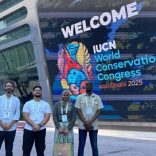Mozambique: INGD inaugurates weather warning system
Mozambique about to create a new ‘Elephant Coast’ Environmental Protection Area

File photo: Notícias
The National Conservation Area Administration (ANAC) is consulting local communities and civil society with a view to establishing, by 2020, a new ‘Elephant Coast’ Environmental Protection Area (EPA) in Maputo province, southern Mozambique.
The Elephant Coast EPA is a land and natural resource management initiative with benefits for both the state and local communities, as they become prime players in its management. It will territories covering the Maputo Special Reserve, Ponta do Ouro Partial Reserve, Inhaca Island, Zitundo, Machangulo and Bela Vista administrative post.
Deputy ANAC Director-General Muhamed Haruna pointed out on Wednesday in Matutuine, Maputo province, that we all have to work on biodiversity conservation for the sake of future generations.
Haruna was addressing an audience of more than 200 people attending a public hearing, and including members of local communities, district government officials, community leaders, civil servants and tour operators.
Haruna said the Matutuine region was an important part of the globe in terms of ecological diversity. On land, there is a richness of fauna, its tourism potential in 1960 leading to the creation of the Maputo Special Reserve. As to its marine part, Haruna explained, it is one of eight areas in East Africa of global importance in terms of biological diversity, with unique coral reefs, and the highest density of nesting leatherback turtle in all of Mozambique.
“The natural heritage of this region provides an opportunity to promote integrated management and to stimulate income growth for the Mozambican state through tourism, fishing and the sustainable exploitation of natural resources,” Haruna said, while cautioning that unregulated fishing could harm the so-called ‘blue economy’.
‘We, the Ministry of Land, Environment and Rural Development (MITADER), have within our remit the aim of fostering integrated management of this landscape, with its specific and exceptional aesthetic, its ecological and cultural qualities, encouraging the development of activities that benefit and promote services important to its residents and neighbours,” he added.
Haruna noted that, in fact, there was a need to better and more effectively categorize this region in the light of current realities in the area, including challenges regarding the sustainable use of existing natural and cultural heritage.
Matutuine District Administrator Artur Muandule noted that this activity formed part of the government’s five-year plan, in the context of promoting good land management practices and income generation for communities and the state, and, above all, the conservation of biodiversity.
“Matutuine already has plenty of tourist infrastructure, so what is now needed is to establish clear rules to prevent the destruction of its unique ecosystems,” Muandula said.












Leave a Reply
Be the First to Comment!
You must be logged in to post a comment.
You must be logged in to post a comment.